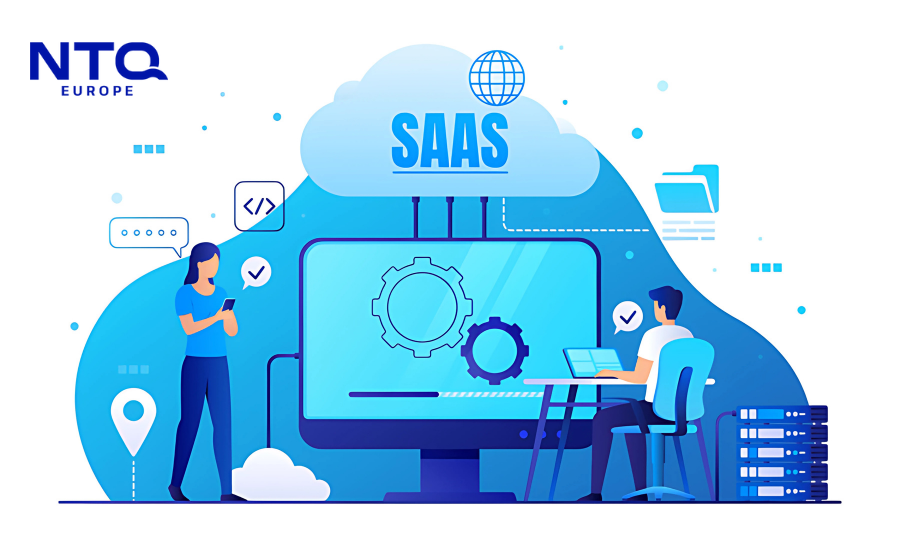1. Introduction to Higher Education Software
In an era where digital transformation is revolutionizing every industry, the higher education sector is no exception. Universities and colleges across the globe, especially in Europe, are actively adopting technology to enhance institutional agility, academic excellence, and student satisfaction. One of the most impactful ways this transformation is unfolding is through the implementation of higher education software.
At its core, software for higher education is designed to digitize and automate complex academic and administrative workflows. From streamlining student admissions to tracking academic performance, these platforms enable institutions to operate more efficiently and deliver better outcomes for students, faculty, and administrators alike.

This transition is not merely a technological upgrade—it’s a fundamental reimagining of how higher education institutions function. By leveraging higher education software solutions, universities are building ecosystems that support remote learning, data-driven decision-making, and enhanced stakeholder communication. In this digital age, embracing smart solutions is no longer optional; it’s essential for long-term competitiveness and institutional success.
2. Core Modules of Higher Education Software
Modern higher education management software is typically modular, allowing institutions to pick and choose functionalities that align with their needs. Let’s explore the core modules that form the backbone of most systems:
2.1 Student Information System (SIS)
At the heart of any platform lies the Student Information System, responsible for centralizing student data—from admissions to graduation. It manages enrollment, attendance, academic history, grades, and credentials, all in one secure hub.
2.2 Faculty and Staff Management
Managing teaching staff and support personnel is crucial. This module enables faculty scheduling, payroll, professional development tracking, and performance reviews, ensuring smooth HR processes.
2.3 Academic and Course Management
Institutions can manage complex course structures, credit systems, elective options, and prerequisites efficiently. Course registration, syllabi uploads, and grading workflows are streamlined, saving time and reducing manual errors.
2.4 Financial and Accounting Module
A robust higher education accounting software module allows for tuition billing, fee tracking, scholarship allocations, expense reporting, and compliance management. Integration with national tax systems and local financial regulations is critical in European markets.
2.5 Housing and Hostel Administration
For universities offering accommodation, the software supports room assignments, occupancy tracking, maintenance requests, and meal plan management.
2.6 Integration with Other Systems
Today’s best higher education software doesn’t work in isolation. It integrates seamlessly with Learning Management Systems (LMS), digital libraries, alumni portals, and analytics platforms. This interoperability ensures a unified experience across all stakeholders.
3. Key Benefits of Using Higher Education Software
The adoption of higher education software brings a multitude of strategic and operational advantages. Let’s break down some of the most significant benefits institutions gain when using these tools.

3.1 Automation of Complex Administrative Workflows
Universities are burdened with a myriad of manual processes—course registration, transcript issuance, fee processing, scheduling, and reporting. Automating these not only saves time but also minimizes human error and ensures consistency. For instance, higher education scheduling software can generate conflict-free timetables in seconds based on predefined parameters.
3.2 Enhanced Experience for Students, Faculty, and Administrators
Student expectations have evolved. They demand quick access to course materials, grades, academic calendars, and communication tools. Modern higher education CRM software empowers institutions to deliver a seamless, engaging, and personalized experience to students while keeping faculty and administrative staff aligned.
3.3 Data-Driven Management
Perhaps the most transformative aspect is the ability to leverage institutional data for smarter decision-making. With built-in analytics and customizable dashboards, leaders can track enrollment trends, student performance, resource utilization, and financial health in real time. This marks a significant shift toward data-driven management in higher education.
4. Types of Higher Education Software
Higher education institutions often rely on a combination of platforms to manage their day-to-day operations. These systems are tailored to different stages of the academic lifecycle—from admissions to alumni engagement. Let’s explore the most common types of higher education software solutions.
4.1 Campus ERP (Enterprise Resource Planning)
This is an all-in-one higher education management software that centralizes administrative and academic functions. A Campus ERP system typically includes modules for finance, HR, student services, asset management, and reporting. It offers a consolidated environment that reduces data silos and facilitates better coordination across departments.
4.2 Learning Management System (LMS)
An LMS focuses on the delivery and management of educational content. It enables institutions to conduct online classes, share course materials, grade assignments, and track student engagement. Popular LMS platforms such as Moodle, Blackboard, and Canvas are frequently integrated into broader ERP ecosystems.
4.3 CRM Software for Higher Education
A robust CRM software for higher education supports student recruitment, communication, and lifecycle management. It helps marketing and admissions teams nurture leads, automate follow-ups, track applicant progress, and improve enrollment conversion rates. For example, with higher education CRM software, institutions can personalize email campaigns or schedule consultations with prospective students based on their interests and location.
4.4 Virtual Learning Environments and Tools
The shift to online and hybrid learning models has led to widespread adoption of virtual classrooms, digital assessment platforms, and content delivery tools. These platforms facilitate real-time interaction between faculty and students while ensuring scalability and accessibility—especially critical in distance and lifelong learning initiatives.
5. Technology Trends in Higher Education Software
Digital transformation in higher education is being fueled by a wave of emerging technologies. Let’s highlight some of the most impactful trends shaping the next generation of software for higher education.
5.1 Artificial Intelligence (AI) and Personalization
AI is enabling personalized learning paths, real-time academic advising, and predictive analytics for student success. Intelligent chatbots are being used to handle student queries, while adaptive learning systems recommend content based on individual performance patterns.
5.2 Mobile Learning and Distance Education
With the rise of smartphones and tablets, mobile-first higher education software is becoming the norm. Students expect to register for courses, access materials, and interact with instructors via their devices. Combined with remote learning platforms, mobile apps are extending institutional reach beyond physical boundaries.
5.3 Learning Analytics and Blockchain Credentials
Learning analytics allow institutions to monitor student engagement and academic performance in real time. These insights help educators tailor their teaching and identify at-risk learners early. Meanwhile, blockchain is emerging as a secure solution for credential management—ensuring that diplomas and certificates are tamper-proof and easily verifiable.
6. Challenges in Developing or Implementing Higher Education Software
Despite its benefits, the deployment of higher education software is not without hurdles. Institutions must plan carefully to avoid common pitfalls and ensure long-term success.
6.1 System Integration with Legacy Tools
Many universities still operate on fragmented systems developed in-house or inherited over decades. Integrating modern higher education software solutions with these legacy platforms can be technically complex and costly. Middleware tools and APIs are essential to bridge these gaps without disrupting ongoing operations.
6.2 Data Security and Compliance
Handling sensitive personal and academic data requires strict compliance with data protection regulations such as GDPR (in Europe) and FERPA (in the US). Institutions must implement robust access controls, encryption mechanisms, and regular audits to secure student records and prevent breaches.
6.3 User Resistance to Change
Faculty, staff, and even students may resist adopting new systems—especially if training is insufficient or user interfaces are unintuitive. Change management strategies, stakeholder engagement, and ongoing support are crucial to driving adoption and maximizing return on investment.
7. Custom vs Off-the-Shelf Higher Education Software
When it comes to selecting the right higher education software, institutions often face the strategic decision between developing custom-built systems or adopting commercial off-the-shelf (COTS) solutions such as SaaS or ERP platforms. Each approach offers unique advantages—and potential drawbacks.
7.1 Custom-Built Solutions
Custom development provides institutions with full control over the system’s architecture, workflows, and integrations. This is ideal for universities with complex organizational structures or unique academic models that generic software may not support.
For example, a custom-built higher education scheduling software can accommodate faculty-specific teaching preferences, multi-campus coordination, and non-traditional calendars. Similarly, custom higher education CRM software may align better with institution-specific outreach strategies or regional enrollment goals.
However, such solutions come with high upfront development costs, longer implementation timelines, and the need for continuous maintenance and upgrades.
7.2 Off-the-Shelf Software (SaaS/ERP)
Commercial solutions are faster to deploy, come with vendor support, and are generally more cost-effective—especially for small and mid-sized institutions. Leading software for higher education often includes best practices and templates, reducing the burden on internal IT teams.

That said, off-the-shelf platforms can lack flexibility. Customizing them to suit highly specific needs might involve additional licensing, third-party plugins, or even expensive custom modules. Institutions must weigh the benefits of speed and reliability against the limitations in personalization.
8. How to Choose the Right Higher Education Software
Making the right technology investment starts with understanding your institution’s unique ecosystem. Here are some best practices to guide the decision-making process:
8.1 Evaluate Internal Needs
Map out current pain points and goals. Does your institution need better student engagement? Improved administrative efficiency? A more agile academic model? Defining your priorities will help narrow down the ideal higher education software solutions.
8.2 Consider Scalability and Budget
Assess not only your current needs but also your long-term vision. Choose a platform that can scale as your institution grows or expands its offerings. Also, consider the total cost of ownership—including licensing, training, support, and future upgrades.
8.3 Prioritize Experienced Vendors
Look for providers with proven expertise in the education sector. A reliable vendor will understand the intricacies of academic workflows and offer responsive support. If CRM is a key focus, prioritize vendors that specialize in CRM software for higher education or higher education marketing software.
9. Why NTQ Europe is a Trusted Higher Education Software Partner
As the higher education landscape evolves, technology is no longer just an enabler—it’s a cornerstone of institutional strategy. From admissions and academics to alumni and analytics, the right higher education software creates a unified, agile, and student-centric environment. Institutions that invest wisely today will lead the future of global education.
At NTQ Europe, we specialize in building tailored digital ecosystems for universities and colleges, with a proven track record across Europe and Asia. Our solutions align with the most stringent compliance standards, including GDPR and HIPAA, and are designed with flexibility, scalability, and user adoption in mind.
We integrate seamlessly with LMS platforms, support mobile-first learning environments, and bring innovations like AI-powered academic advising and blockchain credential verification. Whether you’re seeking a full-scale higher education management software suite or a dedicated CRM software higher education solution, we’re here to deliver strategic value and digital excellence.



















